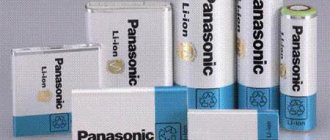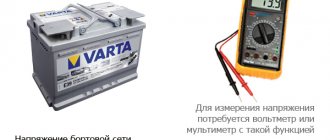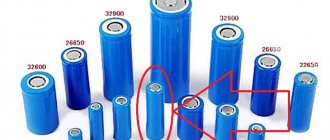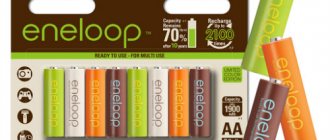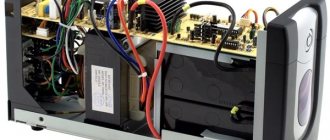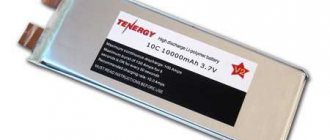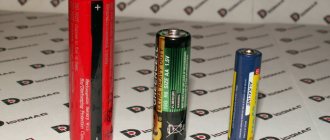How to properly charge a lithium-ion battery and significantly extend the life of 18650 batteries. What current should I use to charge a Li-Ion 18650 battery?
Batteries of this size have several important indicators:
- capacity (mAh – mAh)
- discharge current (A)
- charge current (A)
- maximum number of discharge cycles
In this article, I'll tell you about the last option and how this information can help you extend the life of your batteries.
Which device should you use?
Popular electronics stores offer a wide selection of suitable chargers. The cheapest one, with a current level of 1 ampere, can accommodate one 18650 model battery.
more advanced version, with two “sockets” for elements, with a maximum voltage of 4.2 V. This 18650 charger is a little more expensive, but it does have a charge level indicator that monitors how long the battery needs to charge.
There is also a similar option, with the same characteristics - you can insert not only 18650 cells into it, but also charge a 26650 lithium-ion battery.
You can also purchase a universal charger that is suitable for all types of batteries, from nickel-cadmium to lithium-ion.
There are quite a lot of chargers, and most of them are equipped with both indicators and a safety system that eliminates the need to constantly check the voltage or current level. Of course, the quality of the charger directly depends on how much money will be spent on it.
If you have the skill, time and desire not to waste money on buying a charger, you can make it yourself - of course, this will require a certain circuit.
Types and types of Li Ion 18650 batteries
All 18650 batteries can be divided into types based on cathode material. The main operational characteristics of batteries depend on this component: capacity and possible discharge current.
The most common are lithium-cobalt batteries. They differ from other batteries in their large capacity. Therefore, they can be used longer.
There is also a group of lithium-manganese batteries. Compared to lithium-cobalt batteries, they have a lower capacity, but at the same time have a higher discharge current.
The last group is lithium ferrophosphate batteries. Although they do not have a large capacity or high voltage, they can be operated for more than 1000 cycles. In addition, until fully charged, you need to keep the batteries in the station for 1 hour.
Battery protection
Today, the types of batteries presented are available complete with a special controller or contain manganese. Previously, batteries were produced without protection. In this case, you needed to know how to charge an 18650 battery correctly for your own safety.
The fact is that a device that did not have special protection could overheat greatly if it was charged incorrectly or for too long. In this case, a short circuit and even a fire or explosion of the battery could occur. Today, the use of such structures has sunk into oblivion.
All lithium-ion batteries are designed to protect against such negative phenomena. Most often, a special controller is used. It monitors the battery capacity level. If necessary, it simply turns off the battery. Some types of structures contain manganese. It significantly influences the chemical reactions inside. Therefore, such batteries do not need a controller.
How to charge lithium-ion batteries yourself
The simplest option is to use a mobile phone charger. The devices produce a voltage suitable for restoring the power of 18650 batteries. The method is used only in emergency cases. Its frequent use leads to a decrease in battery capacity.
Homemade charger for a lithium-ion 18650 battery, made from an old phone charger.
To charge the battery, do the following:
- The charger plug is cut off. The wires are stripped of insulation and divided into positive and negative poles. The positive cable most often has a red braid, and the negative cable has a black braid.
- The cleaned wires are attached to the battery poles with plasticine. The USB cable is connected to a computer connector or a special adapter.
- The power source is charged, periodically monitoring the process. It is recommended to charge the battery for no more than an hour. This time is enough to completely restore capacity.
Complex circuits are used to assemble advanced charging. Before starting work, prepare a soldering iron, solder, flux and glue. Separately, purchase the board necessary for the normal functioning of the homemade charger.
The assembly is carried out like this:
- The board is installed in a plastic box prepared in advance. The structure is supplied with positive and negative wires. The box is used to hold the battery while charging. You can make a container from an old charger, an unusable household appliance or a toy. The dimensions must match the battery parameters.
- The board is soldered, taking into account the markings. The markings make it easy to place the wires. The board is equipped with multi-colored indicators that reflect the charging progress. The microcircuit is glued to the box in a convenient place. After this, observing the polarity, connect the wires. Before fixing, they are cleared of insulation and treated with rosin. A small amount of liquid solder is applied to the board.
During the manufacture of the device, short circuits must not be allowed. The above diagram allows you to assemble a simple but reliable charger in a few hours. Using a USB cable, it is connected to an electrical outlet or computer. The battery is installed in the resulting socket. After the green indicator turns on, the device is turned off.
What current can charge 21700?
For a very reasonable price, you get a charger with a 2A charging current, which will allow you to charge a 21700 battery as quickly as possible. And the less capacious 18650 Li-Ion battery will charge even faster. The charging current here will be only slightly more than the recommended 0.5, so you can take it easy and confidently charge.
Interesting materials:
Who was the mother of King David? Who was Yana Poplavskaya's husband? Who was the founder of the Golden Horde state? Who was the founder of the Turkic Kaganate? Who was the first appanage prince of the Moscow principality? Who was the last female pharaoh of the Ptolemaic dynasty? Who was the last khan of the Golden Horde? Who was the ruler of Phenicia? Who was the creator of the first manned spacecraft? Who were the Kipchaks?
Useful tips for using 18650 batteries
Lithium-ion batteries are sensitive to deep discharge. It is not recommended to frequently conduct training aimed at restoring capacity. Proper charging helps extend battery life. The power level should not exceed 90%. When this parameter is increased to 100%, the power supply may quickly lose capacity.
You should not allow a critical discharge. Restoring the original parameters is accompanied by some difficulties. Sometimes deeply discharged elements become unusable. When purchasing products, you need to pay attention to the production date.
Batteries manufactured more than 3 years ago are considered expired. When powering portable equipment, you need to take into account that the battery should not be subject to excessive loads. The battery must be charged taking into account the recommended current and voltage.
General characteristics of 18650
| Capacity (mAh) | Output voltage (V) | Maximum current (A) | Protection board |
| 1100 | 3.3 | +/- | |
| 1300 | 3.6 | 18 | +/- |
| 1620 | 3,6-3,7 | 20 | +/- |
| 2000 | 3,6-3,7 | 20-30 | +/- |
| 2100 | 3,6-3,7 | 20-30 | +/- |
| 2200 | 3,6-3,7 | 20-30 | +/- |
| 2400 | 3,6-3,7 | 20-30 | +/- |
| 2500 | 3,6-3,7 | 20-35 | +/- |
| 2600 | 3,6-3,7 | 20-35 | +/- |
| 2800 | 3,6-3,7 | 20-35 | +/- |
| 3000 | 3,6-3,7 | 20-35 | +/- |
| 3100 | 3,6-3,7 | 20-35 | +/- |
| 3200 | 3,6-3,7 | 20-35 | +/- |
| 3350 | 3,6-3,7 | 20-35 | +/- |
| 3400 | 3,6-3,7 | 20-35 | +/- |
| 3500 | 3,6-3,7 | 20-35 | +/- |
| 3600 | 3,6-3,7 | 20-35 | +/- |
The table shows the most popular batteries.
Dimensions with protection: 66.5*18 mm and 66*18 mm without protection. Weight on average about 40 grams.
Main manufacturers: Samsung, Fenix, Avant, LG, Panasonic, Olight, Camelion, Proconnect, Rombica, SANYO and SONY.
How to charge a 18650 battery
Many chargers (chargers) are universal, but when charging lithium-ion batteries you must follow these rules:
0.5-1 A is the optimal charge current for 18650 batteries.
- At the early stage, it is necessary to apply no more than 0.05 V. Finish the procedure by increasing the parameter to 4.2 V. This value is an acceptable safe level for 18650 batteries.
- The charge current should be 0.5-1 A. With a higher value, the charge will be collected faster. However, it is not recommended to immediately supply a current of 1 A. The indicator should increase smoothly.
- Accelerated charging methods should only be used in emergency cases. The procedure time should not exceed 3 hours. Overcharging damages battery components, causing overheating.
- It is recommended to use devices that automatically monitor charging progress. They turn off automatically after the battery reaches the required power. Cheap and homemade devices are not equipped with controllers, so the user will have to independently monitor the progress of the procedure.
Review of the Olight Perun 2 headlamp with 21700 battery and built-in charger
Having actively engaged in updating previous versions, Olight could not ignore Perun ( review ), at the time of release their brightest headlamp with an 18650 battery. In the new version, in accordance with industry trends, they changed the battery to a capacious 21700 and slightly increased the brightness. I suggest you see what comes of it.
You can buy Olight Perun 2 from an Olight dealer in the Russian Federation
Content
Top 5 Lithium Battery Chargers
Well, for those who do not consider it necessary or possible to assemble a charger for Li-ion with their own hands, we present the most popular devices for charging cylindrical 18650 batteries.
The most popular chargers for lithium-ion cells:
| Rating | Appearance | Model | Manufacturer | Battery size | Number of compartments (independent channels) | Additional functions | price, rub. | Where can I buy |
| 1 | Nitecore D4 | TM Nitecore | AA (R6), AAA (R03), AAAA, C (R14), 26650, 22650, 18650, 10440, 14500, 16340, CR123A, 17670, 17500, 18490, 18350 | 4 | LCD display, testing, determination of electrical capacity, protection against overcharge, polarity reversal, powered by car cigarette lighter | 2 100 | Ya.Market | |
| 2 | Liitokala Lii-500 | Liitokala | 18650, 18490, 18350, 17670, 17500, 17335, 16340 (RCR123), 14500, 10440, 26650, 22650, 26500, A, AA, AAA, SC | 4 | LCD display, testing, determination of electrical capacity, protection against overcharge, polarity reversal, USB port 5 V/1A | 2 400 | Ya.Market | |
| 3 | Opus BT-C3100 v2.2 | Opus | AA, AAA, C (R14), 10440, 16340, 14500, 17500, 17335, 17500, 18490, 17670, 18650, 22650, 26650 | 4 | LCD display, testing, determination of electrical capacity, protection against overcharge, polarity reversal, multi-stage charging | 2 900 | Ya.Market | |
| 4 | SkyRC MC3000 | SkyRC | AA, AAA, C, D, SC, AAAA, 18650, 14500, 16340, 32650, 14650, 17670, 10440, 18700, 18350, RCR123, 18500, 18490, 25500, 13500, 13450, 1665 0, 22650, 17500, 10340, 17650, 10500, 26500, 12340, 12500, 12650, 14350, 14430, 16500, 17350, 20700, 21700, 22500, 32600 | 4 | LCD display, testing, determination of electrical capacity, protection against overcharge, polarity reversal, remote control via Bluetooth 4.0, temperature control, USB port 5 V/2.1A, powered from the vehicle’s on-board network | 7 100 | Ya.Market | |
| 5 | Palo P10 | Palo | AA, AAA | 8 | LED indication, fixed charging current at 180 or 200 mA, pair charging, low price | 900 | – |
